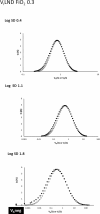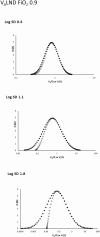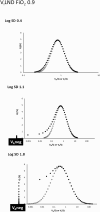Multi-compartment V/Q lung modeling: Log normal distributions of inspired or expired alveolar gas?
- PMID: 39218587
- PMCID: PMC11366441
- DOI: 10.14814/phy2.16175
Multi-compartment V/Q lung modeling: Log normal distributions of inspired or expired alveolar gas?
Abstract
Using a 50-compartment Python-coded mathematical lung model, we compared mixed venous blood flow (Q) distributions and arterial oxygen tension/inspired oxygen fraction (PaO2/FiO2) relationships in lungs modeled with log normal distributions (LND) of inspired (VI) versus expired (VA) alveolar gas volumes. In lungs with normal V/Q heterogeneity, Q versus VA/Q and Q versus VI/Q distributions were similar with either approach, and PaO2/FiO2 sequences remained indistinguishable. In V/Q heterogeneous lungs at high FiO2, VILND generated low Q versus VA/Q shoulders and some negative VA units, while VALND preserved Q versus VA/Q log normality by blood flow diversion from low VI/Q units. We managed VILND-induced negative VA units either by shunt conversion (VI decreased to 0) or VI redistribution simulating collateral ventilation (VI increased till VA = 0). Comparing oxygen transfer: VALND > VILND (redistribution) > VILND (shunt). In V/Q heterogeneous lungs VALND and VILND (redistribution) regained near optimal oxygen transfer on 100% oxygen, while impairment persisted with VILND (shunt). Unlike VALND, VILND (redistribution) produced Q versus VA/Q distributions in V/Q heterogeneity compatible with multiple inert gas (MIGET) reports. VILND (redistribution) is a physiologically-based MIGET-compatible alternative to West's original VALND lung modeling approach.
Keywords: MIGET; V/Q model; alveolar gas; expired; inspired; log normal.
© 2024 The Author(s). Physiological Reports published by Wiley Periodicals LLC on behalf of The Physiological Society and the American Physiological Society.
Conflict of interest statement
The authors declare that they have no competing interests.
Figures







References
-
- Daly, B. D. , Parks, G. E. , Edmonds, C. H. , Hibbs, C. W. , & Norman, J. C. (1975). Dynamic alveolar mechanics as studied by videomicroscopy. Respiration Physiology, 24, 217–232. - PubMed
-
- Dantzker, D. R. , Brook, C. J. , Dehart, P. , Lynch, J. P. , & Weg, J. G. (1979). Ventilation‐perfusion distributions in the adult respiratory distress syndrome. The American Review of Respiratory Disease, 120, 1039–1052. - PubMed
-
- Dantzker, D. R. , Wagner, P. D. , & West, J. B. (1974). Proceedings: Instability of poorly ventilated lung units during oxygen breathing. The Journal of Physiology, 242, 72P. - PubMed
-
- Desplechain, C. , Foliguet, B. , Barrat, E. , Grignon, G. , & Touati, F. (1983). The pores of Kohn in pulmonary alveoli. Bulletin Européen de Physiopathologie Respiratoire, 19, 59–68. - PubMed
-
- Domino, K. B. , Eisenstein, B. L. , Tran, T. , & Hlastala, M. P. (1993). Increased pulmonary perfusion worsens ventilation‐perfusion matching. Anesthesiology, 79, 817–826. - PubMed
MeSH terms
Substances
Grants and funding
LinkOut - more resources
Full Text Sources
Medical

